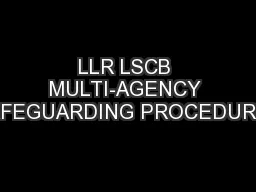

37 Escalation of Concerns and Resolving Practitioner Disagreements httpllrscbproceduresonlinecomchapterspresprofdisaghtml Context This procedure has been developed in line with the guidance set out in ID: 536331
Download Presentation The PPT/PDF document "LLR LSCB MULTI-AGENCY SAFEGUARDING PROCE..." is the property of its rightful owner. Permission is granted to download and print the materials on this web site for personal, non-commercial use only, and to display it on your personal computer provided you do not modify the materials and that you retain all copyright notices contained in the materials. By downloading content from our website, you accept the terms of this agreement.
Slide1
LLR LSCB MULTI-AGENCY SAFEGUARDING PROCEDURES
3.7 Escalation of Concerns and Resolving Practitioner Disagreementshttp://llrscb.proceduresonline.com/chapters/p_res_profdisag.htmlSlide2
Context
This procedure has been developed in line with the guidance set out in Working Together to Safeguard Children: March 2015A guide to inter-agency working to safeguard and promote the welfare of children
http://www.workingtogetheronline.co.uk/ Findings from Serious Case Reviews/Learning ReviewsSlide3
Principles of Resolving Practitioner Disagreement
At no time must practitioner disagreement detract from ensuring that the child is safeguarded. The child’s welfare must remain paramount
throughoutSlide4
Practice Principles of Resolving Practitioner Disagreement
• All practitioners should take responsibility for their own cases, and their actions in relation to such case work.
• Difficulties at practitioner / fieldworker level between agencies should be resolved as simply and quickly as possible.• All practitioners should respect the views of others, whatever their level of experience. They should also be mindful of the difficulties that challenging more senior or experienced practitioners may present to others.
• Working Together effectively depends on an open approach and honest relationships between agencies
.
• Working together effectively also depends on resolving disagreements to the satisfaction of workers and agencies, with a genuine commitment to partnership
.
•
Practitioner
disputes are reduced by clarity about roles and responsibilities, and airing and sharing problems in networking forums. Slide5
Escalating a Concern
Disagreements can arise in a number of areas of multi-agency working but are most likely to arise in relation to:Thresholds into services; Outcomes of assessments;Decision making;Roles and responsibilities of workers;Service provision;Information sharing and communication.Slide6
Flowchart: Practitioner Disagreement Escalation and Resolution Procedure
Escalating a concern arising from differing
practitioner view or disagreement to decisions made or actions taken at any stage of the safeguarding process
STEP 1:
Direct Practitioner to Practitioner
Discussion
Differences
of opinion or judgment should be discussed amongst frontline
practitioners
to attempt to achieve a shared understanding and agree a local resolution, in line with the plan, or to ensure a plan is developed if needed
STEP 2:
Direct Manager to Manager Discussion
If
Step 1 does not resolve the issue then each
practitioner should
discuss the issue with their line manager or safeguarding supervisor. The line manager should review the concerns and ensure that they are justified and meet the purpose of this protocol. The line manager should then liaise with the other
agency practitioners
line manager in an attempt to reach a resolution.
Consultation
with senior managers
(
eg
equivalent SM/HoS) within each organisation can be used if this would be felt to assist resolution.
In circumstanceswhere a practitioner / agency believes that a child is at risk of Significant Harm, then, the escalation must be made on the same working day.
Following satisfactory resolution Any general principles should be identified and referred to the LSCB for discussion and further learning.It may also be helpful for individuals to debrief following disagreements, in order to promote continuing good working relationships.
STEP 3: Where practitioner differences remain unresolvedWhere agreement cannot be reached at Steps 1 & 2; the matter must be referred to the Designated Safeguarding Lead within your own agency. A professionals meeting should then be convened, chaired by the Children’s Services Service Manager/HoS.If the agency who raised the initial concern remains unsatisfied that agency's Designated Safeguarding Lead/Senior Officer should refer the matter to the LSCB.
STEP 4: The LSCB Manager should determine a course of action, if all steps to resolve the matter fail and/or discussions raise a policy issue. This should include reporting the matter to the LSCB Independent Chair, who would then consider the merit of convening a Senior Officer Resolutions Meeting to resolve the disagreement.The outcome of any discussions at this stage will be fed back to your own agency’s Designated Safeguarding Lead/Senior Officer.
Practitioners and Managers can seek advice from the Safeguarding Unit Manager (LLR) or Named Nurses (Health professionals) or respective leads for safeguarding within their organisation, i.e. Police,Probation and Education ServicesSlide7
Key Messages
Follow the procedure and act promptlyClearly identify your concern and the impact this has on the child(ren)
Try to resolve the issue practitioner to practitionerProvide a written account of your concerns and make a record of your conversationRespond to requests for further informationEnsure you are clear of the outcome of any discussions held (including any contingency arrangements to assure the child(rens) safety